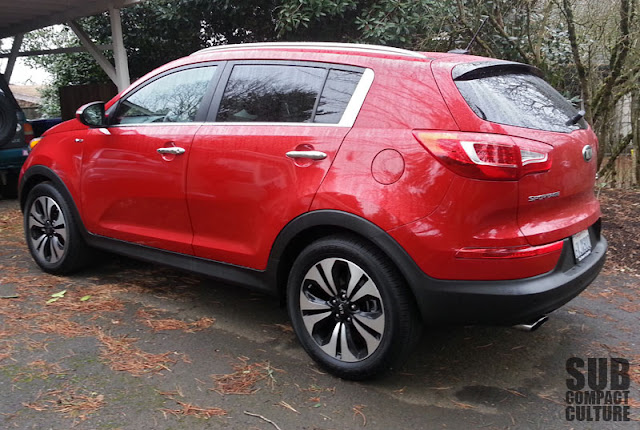This go around with the Sportage, we found the steering to be almost too light and it could’ve been faster. However, thanks in part to its high performance shocks, as Kia calls them, the vehicle handles confidently with minimal roll in corners and strong grip. It’s not as sporting as the Mazda CX-5, but it still hugs the road quite well. Another handling note: The Sportage has a surprisingly good turning radius, something I don’t tend to find in CUVs. One thing we did notice is iffy rear visibility, due in part to the narrow rear window. Changing lanes takes a bit of care due to this. Backing up is aided by the reverse camera, thankfully.
But let’s get to the main point here. The SX is all about the turbo engine. This mill churns out 260 horsepower—84 more horses than the 2.4 in the EX. It also makes 269 ft./lbs. of torque, which is a healthy 101 more ft./lbs. than the normally aspirated engine. Needless to say, this turns the Sportage into a quick CUV. Of course, this is also the all-wheel-drive model, which means traction is not an issue. I read reports of 0-60 sprints in about 7.0 seconds flat. Punch the throttle from a standstill, and the car leaps into action with little turbo lag, and produces impressive acceleration. Mash the gas from speed, and you’ll be rewarded with plenty of gusto. It can be a bit surprising at points; you don’t expect this car to be as fast as it is at times. It’s a good little powerplant, although I would love to hear a bit more exhaust note or something. See, the engine sounds exceedingly mechanical, likely due to its direct injection fuel delivery. Power is put to the ground via a six-speed automatic transmission with manual shifting capabilities. The transmission worked seamlessly and provided smooth, quick shifts. The AWD system features a center locking differential, which is good for deep snow, sand, or mud, and there’s also hill decent control and hill hold.
So all that power must mean decreased fuel economy, right? Yes, but by only one minuscule MPG (combined) vs. the non-turbo 2.4-liter engine, which is pretty shocking considering the power difference. Our turbo model is rated at 20 city and 25 highway, vs. 20 city and 27 highway in the non-turbo AWD model. We got just over 19 mpg in mostly city driving. Plus, it runs on 87 octane gas, so no need to pump it full of the expensive stuff.
Inside, the Sportage is a comfortable, well-appointed, and solidly built place to spend some time. There’s a great sound and infotainment system, leather seats with blazing hot seat heaters (and an air conditioned driver’s seat), and the panoramic double glass roof panels (the forward one is an operational moonroof) really help keep the interior light and airy—definitely a high point. Of course, the interior is just as versatile and spacious as the ’11 EX model we reviewed. We easily hauled a big load of stuff to Goodwill with room to spare. The exterior is nearly identical to the ’11 EX we tested, with the exception of a mesh grille vs. a multi-bar grille.
In my opinion, if you’re going to buy an optioned-out Kia Sportage, you might as well get the SX model instead of a fully loaded EX. Our SX cost $32,400, a difference of only about $1,500 compared to a top-of-the-line EX, which has much less power. If you’re only looking for a mid-level EX or perhaps an LX model, then I could see passing on the SX, since $32,400 is a good chunk of change. But if you’re thinking of spending over $30K on any automaker's CUV and want something that can really get out of its own way (and pass up a lot of slower vehicles), the Sportage SX is certainly worth driving.





No comments:
Post a Comment